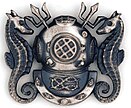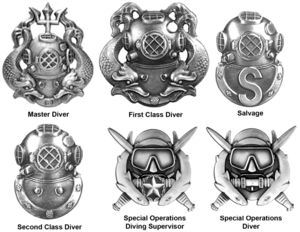Underwater divers may be employed in any branch of an armed force, including the navy, army, marines, air force and coast guard. Scope of operations includes: search and recovery, search and rescue, hydrographic survey, explosive ordnance disposal, demolition, underwater engineering, salvage, ships husbandry, reconnaissance, infiltration, sabotage, counterifiltration, underwater combat and security.
Ensign is a junior rank of a commissioned officer in the armed forces of some countries, normally in the infantry or navy. As the junior officer in an infantry regiment was traditionally the carrier of the regimental colours, the rank acquired the name. This rank has generally been replaced in army ranks by second lieutenant. Ensigns were generally the lowest-ranking commissioned officer, except where the rank of subaltern existed. In contrast, the Arab rank of ensign, لواء, liwa', derives from the command of units with an ensign, not the carrier of such a unit's ensign, and is today the equivalent of a major general.

In the United States (U.S.), a marksmanship badge is a U.S. military badge or a civilian badge which is awarded to personnel upon successful completion of a weapons qualification course or high achievement in an official marksmanship competition. The U.S. Army and the U.S. Marine Corps are the only military services that award marksmanship qualification badges. However, marksmanship medals and/or marksmanship ribbons are awarded by the U.S. Navy, U.S. Coast Guard, and U.S. Air Force for weapons qualifications. For non-military personnel, different U.S. law enforcement organizations and the National Rifle Association (NRA) award marksmanship qualification badges to those involved in law enforcement. Additionally, the Civilian Marksmanship Program (CMP) and the NRA award marksmanship qualification badges to U.S. civilians. Most of these organizations and the U.S. National Guard award marksmanship competition badges to the people they support who succeed in official competitions.
The Observer Badge is a military badge of the United States armed forces dating from the First World War. The badge was issued to co-pilots, navigators, and flight support personnel who had received a variation in the training required for the standard Pilot's Badge. The Observer Badge survived through the Second World War and into the 1950s, at which time the concept of an Observer Badge was phased out in favor of the modern Aircrew Badge and Navigator-Observer Badges. In addition to wings for Naval Aviators and Naval Flight Officers, the United States Navy still maintains an "Observer Badge" which is issued to flight-qualified mission specialists, such as a select number of meteorologists and intelligence officers in both the U.S. Navy and U.S. Marine Corps. The U.S. Air Force awards its USAF Observer Badge, which is identical to the USAF Navigator Badge, to Air Force officers who have qualified as NASA Space Shuttle Mission Specialists, have flown an actual mission aboard the shuttle and/or the International Space Station and who are otherwise not previously aeronautically rated as an Air Force pilot or navigator.

The U.S. military issues instructor badges to specially training military personnel who are charged with teaching military recruits the skills they need to perform as members of the U.S. Armed Forces or teach continuing education courses for non-commissioned officers and officers in the military. With the exception of the U.S. Army and U.S. Coast Guard, these badges are considered temporary military decorations and must be surrendered upon completion of one's duty as a military instructor. Because of this, the U.S. Air Force, U.S. Navy and U.S. Marine Corps award Drill Instructor Ribbons as a permanent decoration to recognize service members who have qualified and performed as military instructors.

A United States Aviator Badge refers to three types of aviation badges issued by the United States Armed Forces, those being for Air Force, Army, and Naval aviation.

The Parachutist Badge, also commonly referred to as "Jump Wings", is a military badge of the United States Armed Forces. Some services, such as the Marine Corps, officially refer to it as an insignia instead of a badge. The United States Space Force and United States Coast Guard are the only branches that do not award the Parachutist Badge, but their members are authorized to receive the Parachutist Badges of other services in accordance with their prescribed requirements. The DoD military services are all awarded the same Military Parachutist Badge. The U.S. Army and U.S. Air Force issue the same Senior and Master Parachutist Badges while the U.S. Navy and U.S. Marine Corps issue the Navy and Marine Corps Parachutist Insignia to advanced parachutists. The majority of the services earn their Military Parachutist Badge through the U.S. Army Airborne School.

Identification badges of the uniformed services of the United States are insignia worn by service members conducting special duties, many of which can be awarded as permanent decorations if those duties are performed successfully. There are a few identification badges that are awarded to all services, others are specific to a uniform service. The Office of the President and Vice President and department/service headquarters badges are permanent decorations for those who successfully serve in those assignments. Some of the service level identification badges can be permanent decorations and others are only worn by a service member while performing specific duties, such as the Military Police Badge.

Insignias and badges of the United States Navy are military badges issued by the United States Department of the Navy to naval service members who achieve certain qualifications and accomplishments while serving on both active and reserve duty in the United States Navy. Most naval aviation insignia are also permitted for wear on uniforms of the United States Marine Corps.

Obsolete badges of the United States military are a number of U.S. military insignia which were issued in the 20th and 21st centuries that are no longer used today. After World War II many badges were phased out of the United States Armed Forces in favor of more modern military badges which are used today.

Insignia and badges of the United States Marine Corps are military "badges" issued by the United States Department of the Navy to Marines who achieve certain qualifications and accomplishments while serving on both active and reserve duty in the United States Marine Corps.
In the United States Armed Forces, a line officer or officer of the line is a U.S. Navy or U.S. Marine Corps commissioned officer or warrant officer who exercises general command authority and is eligible for operational command positions, as opposed to officers who normally exercise command authority only within a Navy Staff Corps. The term line officer is also used by the U.S. Air Force and U.S. Coast Guard to indicate that an officer is eligible for command of operational, viz., tactical or combat units. The term is not generally used by officers of the U.S. Army – the roughly corresponding Army terms are basic branch and special branch qualified officers, although the concepts are not entirely synonymous, as some Army special branch officers are eligible to hold command outside their branch specialty.

A United States Navy diver may be a restricted fleet line officer, Civil Engineer Corps (CEC) officer, Medical Corps officer, an Unrestricted Line Officer who is qualified in Explosive Ordnance Disposal (EOD) Warfare (1140) or an enlisted who is qualified in underwater diving and salvage. Navy divers serve with fleet diving detachments and in research and development. Some of the mission areas of the Navy diver include: marine salvage, harbor clearance, underwater ship husbandry and repair, submarine rescue, saturation diving, experimental diving, underwater construction and welding, as well as serving as technical experts to the Navy SEALs, Marine Corps, and Navy EOD diving commands.
In the uniformed services of the United States, captain is a commissioned-officer rank. In keeping with the traditions of the militaries of most nations, the rank varies between the services, being a senior rank in the naval services and a junior rank in the ground and air forces. Many fire departments and police departments in the United States also use the rank of captain as an officer in a specific unit.

The US employs divers in several branches of the armed forces, including the navy, army, marines, air force and coast guard.

Army engineer divers are members of national armies who are trained to undertake tasks underwater, including reconnaissance, demolition, and salvage. These divers have similar skills and qualifications as professional divers. Army divers use both surface supplied "Hard hat" and SCUBA to perform their missions. In the United States Army, they are members of the Corps of Engineers. In the British Army, they may be Royal Engineer Divers or Commando Engineer Divers.

The United States Air Force Combat Diver Course—administratively known as the 350th Battlefield Airmen Training Squadron, Det 2—is held at the Navy Diving Salvage and Training Center, Naval Support Activity Panama City and trains Pararescuemen, Combat Rescue Officers, Combat Controllers, and Special Tactics Officers to conduct and participate in special operations diving missions.

Special Forces Underwater Operations (SFUWO) is the term for United States Army Special Forces combat operations involving the use of underwater infiltration methods. These typically involve the use of closed circuit dive equipment to infiltrate a beach landing site (BLS) undetected. The US Army Special Forces, also known as Green Berets have been conducting maritime operations and underwater operations since their founding in 1952. Currently, each company within a Special Forces Group mans, trains, equips, and deploys a SFUWO Operation Detachment Alpha (SFOD-A). These twelve-man teams train for SFUWO as their primary infiltration method when conducting one of their missions of unconventional warfare, direct action, counter-terrorism, foreign internal defense, among others.


























